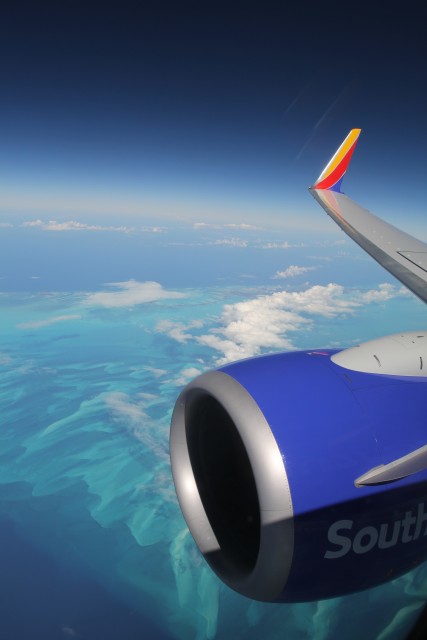
Over the Caribbean Sea – Photo: David Delagarza | AirlineReporter
That’s one small flight for a 737, one giant leap forward for Southwest Airlines and Houston Hobby Airport (HOU). In a sign of things to come, Southwest added to its daily Aruba service out of Baltimore and Orlando with a seasonal weekly flight between Houston and Aruba’s Queen Beatrix International Airport (AUA). Last Saturday, I joined Southwest for the inaugural flight between Aruba and Houston. This flight was the first international commercial arrival into Hobby airport.
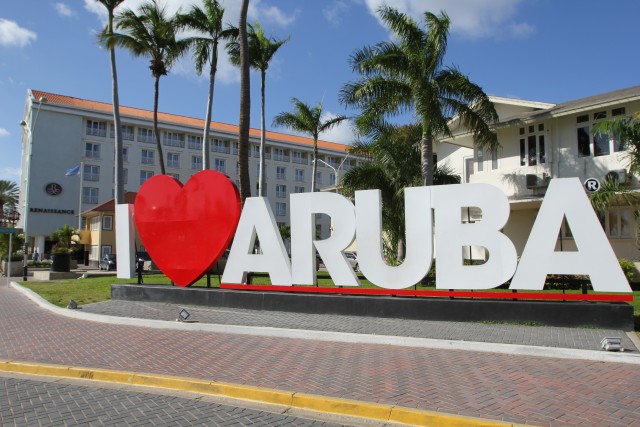
I ⥠Aruba, the unofficial theme of the island – Photo: David Delagarza | AirlineReporter
Although Hobby Airport does not have customs and immigration facilities, Southwest is able to operate the flight thanks to the Customs and Border Patrol (CBP) preclearance facility in Aruba, which allows passengers to clear customs and immigration prior to departing for the United States. This October, however, Hobby Airport is scheduled open a new five-gate international terminal, complete with customs and immigration facilities, which will enable Southwest to further add to its international offerings at Houston.
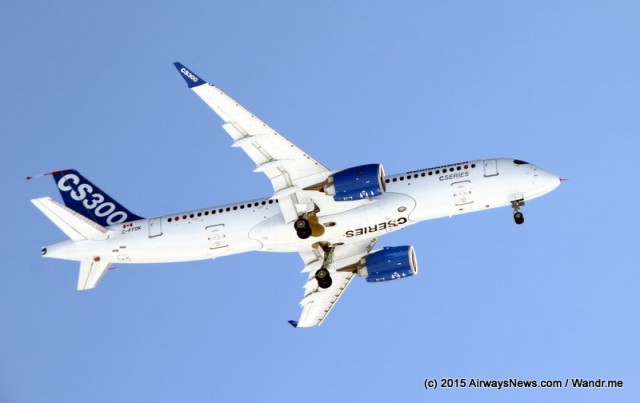
Bombardier CSeries CS300 takes flight for the first time – Photo: Seth Miller | AirwaysNews
The full story was written by Seth Miller on AirwaysNews.com.
The Bombardier CS300, the newest commercial aircraft on the market, made its maiden flight just after 11:00 a.m. yesterday at Montreal’s Mirabel airport. The larger CSeries variant follows the smaller CS100, which took to the skies 17 months ago.
For Bombardier, this is a significant step forward for a project which has seen its share of challenges. As a “clean-sheet’ aircraft design, such challenges are not unexpected; Boeing and Airbus experienced similar delays with the 787 and A350, respectively. Bombardier’s new CEO, Alain M. Bellemare, described the event as ’œan inflection point’ in the CSeries project, ’œwhere we’re finally reaching momentum and we can go to market with a solid product for our customers.’
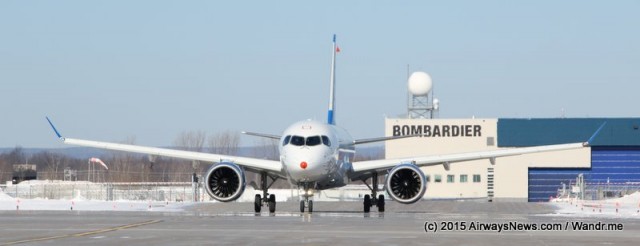
The first CS300 taxis – Photo: Seth Miller | Airways News
The test flight came on the second day of the three-day window Bombardier allotted for the event. Initial plans to run the test flight on Thursday were hampered by cold weather, wind, and snow earlier in the week in Mirabel; that weather prevented final pre-flight testing from happening. It was colder yesterday than earlier in the week ’“ probably the coldest first flight ever ’“ but the low temperatures did not prevent the first flight.
With both the CS100 and CS300 now flying, the company is able to aggressively push towards the completion of the flight test regimen and enter the airliner into service. It is also worth noting that the CSeries plan is somewhat unusual in having both types flying test flights concurrently rather than a sequential process of EIS on the first followed by testing of the second. Delays in the CS100 test program can be blamed in part for these circumstances.
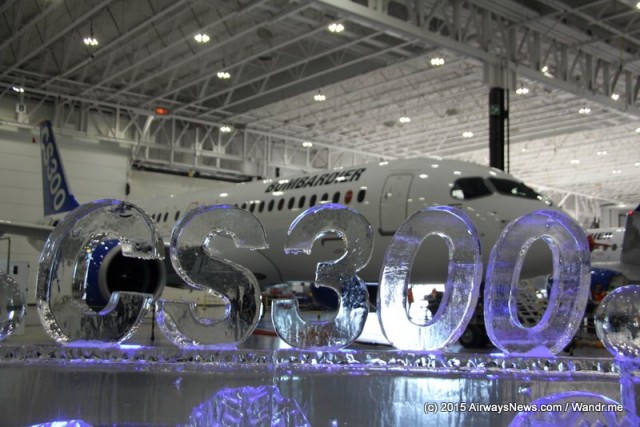
A special CS300 ice sculpture to celebrate the first flight – Photo: Seth Miller | AirwaysNews
The CSeries aircraft promises a more comfortable passenger cabin combined with lower costs for the airlines and quieter operations for the passengers and those who live near the airports. While the interior of the CS300 is not yet on display to media, the noise aspect was demonstrated during the first flight departure; the CRJ900 ’“ a quiet plane in its own right ’“ was notably louder than the CS300 flying just ahead of it during the first flight departure.
Continue reading Bombardier CSeries CS300 Achieves First Flight on AirwaysNews.com
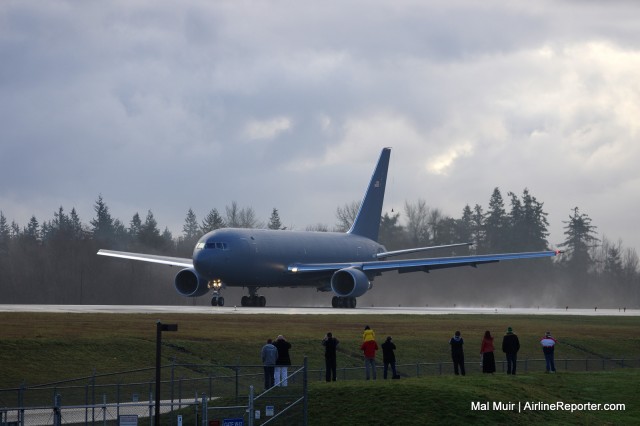
People line up at the ever-popular “Windsock” at Paine Field – the 767-2C is just about to begin its maiden flight
9:40 am on a wet and grey Sunday morning in Seattle saw the first flight of an aircraft with a tumultuous history. This wasn’t a 787 or the A350, this was a Boeing aircraft that has not had much in the way of press in recent times. However, in the past that was a different story.
The first 767-2C, the prototype that will lead to the beginning of the KC-46 program took to the air for the first time. With it, over 12 years of history will see the USAF’s new tanker project finally start to fly.
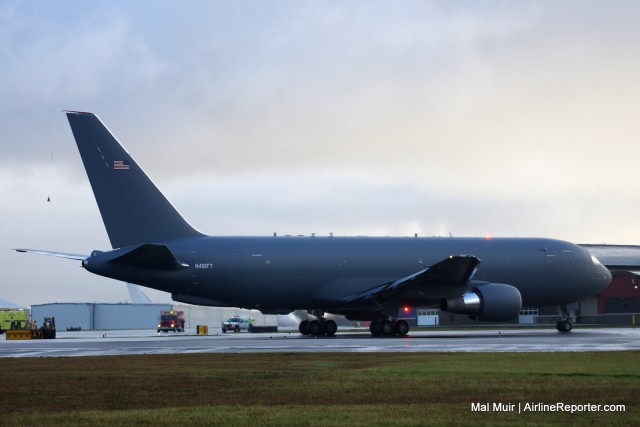
The first 767-2C exits the runway in Everett due to a malfunction in the telemetry control. It was able to get back to the planned flight departure a few minutes later.
The first flight of the 767-2C is not technically a KC-46 Pegasus tanker, but the first of four aircraft destined for the testing of this unique aircraft. A hybrid aircraft of sorts,- made up of the fuselage of a 767-200, the wings of a -300ER, and then throw in the cockpit of Boeing’s latest aircraft, the 787, and you have this almost frankensteinish aircraft that will perform, what some think of as, the most unnatural of airborne feets, refueling other aircraft mid-flight.
Boeing’s history, not only with tankers but with this program alone, could fill page after page. Let’s try and condense it down, shall we?
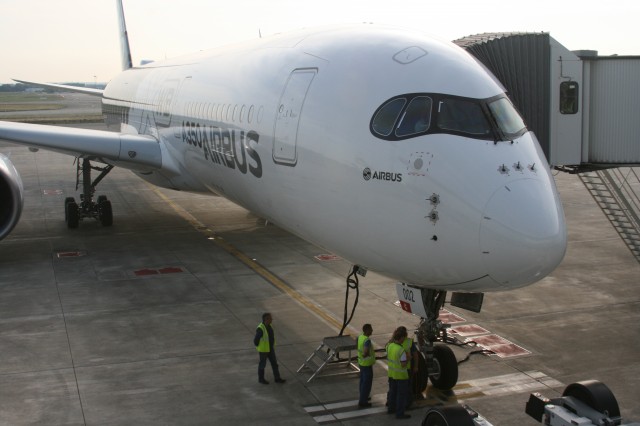
The Airbus A350 (MSN002) waiting to be boarded – Photo: Owen Zupp
A flight test program is a finely-tuned schedule, down to the most detailed demonstration, with every minute of flight time accounted for. The deadlines of certification and delivery loom ever-closer as the engineers and pilots continue to put the aircraft through its paces. Still, recently, Airbus was able to somehow wedge a 60-minute flight into their A350 XWB timeline to showcase their newest family member to a media contingent visiting Toulouse for their ‘Airbus Innovations 2014’. I was fortunate to be one of those that flew aboard that flight.
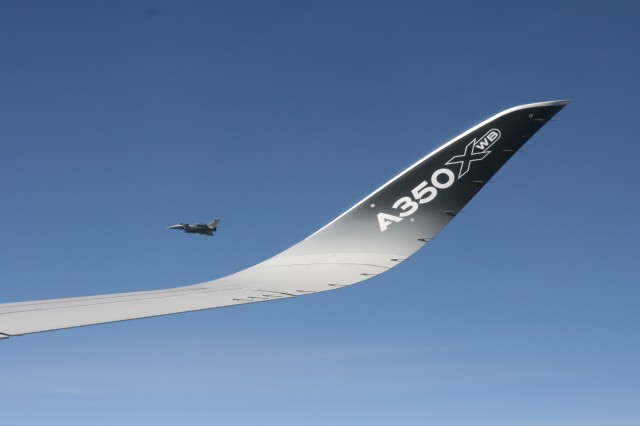
The A350 wingtip with special escort – Photo: Owen Zupp
The fact that Airbus was prepared to conduct the flight reflects two rather key points. Firstly, that their flight test program is on track and secondly, that they are confident enough in their product to take a load of media scribes aloft. Furthermore, Airbus created specific social media channels for the journalists to share the flight with the world. Consequently, there was a buzz of texting and tweeting as 200 passengers cleared a security channel and filed down the aero-bridge.
The aircraft’s cabin was still in flight test mode, so interspersed amongst the passenger seats were stations of data-gathering equipment, computer screens, and cables taped to the floor. Even so, as one walked through business class and into the economy cabin, there was still that new airplane smell. The interior boasted all of the mod-cons of inflight entertainment systems and even the fasten belt sign was a scrolling digital display. As we all settled in, there was no mistaking that this was a new generation of passenger jet and we were very privileged to take flight.
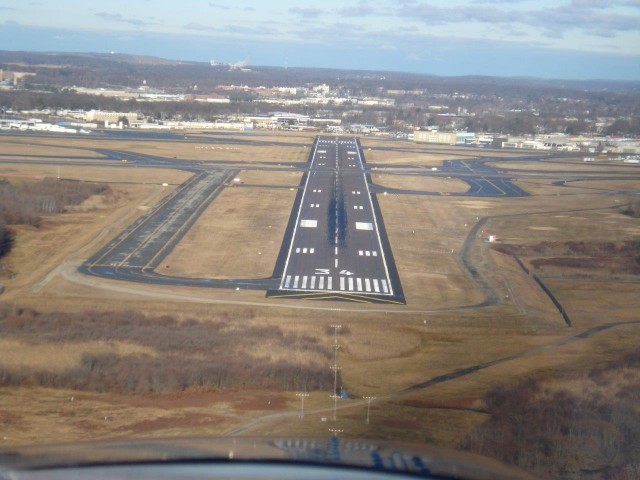
Coming in for a landing – Photo: Graeme J W Smith
Lunchtime ’“ I arrive at Airport Road in Warwick, having driven past the usual airport entrance and around the end of the field. There are hangars behind the fence, a big ’œLearn to Fly Here’ sign on the end of the large hangar. A trail of little yellow airplanes painted on the sidewalk leads to the school door in the old control tower building. I go through the door. A counter ’“ I’m immediately greeted by a young guy whose name badge said Chris. There are aviation prints, flags from around the world from people who learned at the school, a case with headsets and aircraft models, some seats, and magazines.
We do some paperwork. Chris detects my Scottish accent. He will need to perform a background check on me before I am ever able to solo. A legacy from 9/11. I explain I’m actually an American and produce a US Passport. Clearly this has just saved a ton of extra paperwork. Big smile from Chris. We talk about – what else – flying. My instructor is finishing up with the last student ’“ he will be right with me.
Someone appears through a door telling the person who is clearly a student what they will do next time. I’m introduced to Greg. He snags me a guest headset from the school’s loaner pile, grabs a flight box for an aircraft, and takes me down to the classrooms on the side of the hangar. Each desk has a computer, books, and some aviation print or similar. We sit down at his and go over what is about to happen. We are cautiously sounding each other out. We turn to the computer and get a volume of information from it (don’t worry, it gets easier with time) weather, standard briefing, radar picture, METARS, TAF’s, TFR’s and NOTAMS all written in code and requiring interpretation. I note the website we are using for later study. We do this before EVERY flight. Especially TFR’s ’“ Temporary Flight Restrictions ’“ they can pop up at a moment’s notice and leave you grounded or in big trouble if you fly.









